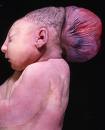|
|
|
|
Anencephaly
Anencephaly is a cephalic disorder that results from a neural tube defect that occurs when the cephalic (head) end of the neural tube fails to close, usually between the 23rd and 26th day of pregnancy, resulting in the absence of a major portion of the brain, skull, and scalp. Children with this disorder are born without a forebrain, the largest part of the brain consisting mainly of the cerebral hemispheres (which include the isocortex, which is responsible for higher level cognition, i.e., thinking). The remaining brain tissue is often exposed—not covered by bone or skin.
Encephaloceles
Encephaloceles are rare neural tube defects characterized by sac-like protrusions of the brain and the membranes that cover it through openings in the skull. These defects are caused by failure of the neural tube to close completely during fetal development. The result is a groove down the midline of the upper part of the skull, or the area between the forehead and nose, or the back of the skull. When located in the back of the skull, encephaloceles are often associated with neurological problems. Usually encephaloceles are dramatic deformities diagnosed immediately after birth, but occasionally a small encephalocele in the nasal and forehead region can go undetected. Encephaloceles are often accompanied by craniofacial abnormalities or other brain malformations. Symptoms and associated abnormalities of encephaloceles may include hydrocephalus (excessive accumulation of cerebrospinal fluid in the brain), spastic quadriplegia (paralysis of the arms and legs), microcephaly (abnormally small head), ataxia (uncoordinated movement of the voluntary muscles, such as those involved in walking and reaching), developmental delay, vision problems, mental and growth retardation, and seizures. Some affected children may have normal intelligence. There is a genetic component to the condition; it often occurs in families with a history of spina bifida and anencephaly in family members.
Spina Bifida
Spina bifida is
a serious birth defect that occurs when the tissue surrounding the developing spinal cord of a fetus doesn't close properly. Spina bifida is part of a group of birth defects
called neural tube defects. The neural tube is the embryonic structure that eventually develops into the baby's brain and
spinal cord and the tissues that enclose them. In babies with spina bifida, a portion of the neural tube fails to develop
or close properly, causing defects in the spinal cord and in the bones of the backbone. Spina bifida is one of the more common birth defects in
the United States. When treatment for spina bifida is necessary, it's done through surgery, although such treatment doesn't
always completely resolve the problem. Symptoms
Spina bifida occurs in three forms, each varying in severity:
An abnormal tuft of hair, a collection of fat, a small dimple or a birthmark
on the newborn's skin above the spinal defect may be the only visible indication of the condition. In fact, most people who
have spina bifida occulta don't even know it, unless the condition is discovered during an X-ray for unrelated reasons.
In myelomeningocele, the baby's spinal canal remains open along several vertebrae in the lower
or middle back. Because of this opening, both the membranes and the spinal cord protrude at birth, forming a sac on the baby's
back. In some cases, skin covers the sac. Usually, however, tissues and nerves are exposed, making the baby prone to life-threatening
infections. Neurological impairment — often including loss of movement (paralysis) — is common. So are bowel and bladder problems, seizures and other medical complications.
[ Back ]
|
|
|
|

